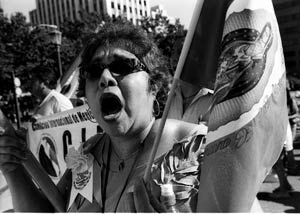 |
 |
 |
 Editorials | Issues | October 2006 Editorials | Issues | October 2006  
Border-Wall Plans Prompt New Debates
 Carlos Guerra - San Antonio Express-News Carlos Guerra - San Antonio Express-News


| | Now that the Secure Fence Act is law, many border-area residents finally understand what will go up in their backyards, and they and others are voicing doubts. (Meg Loucks) |
Even when it was just being discussed, the notion of building a wall along the Mexican border fostered spirited debates. Proponents argued that only a wall would stop the flow of undocumented migrants. Opponents countered that since the Great Wall of China, border walls have provided little more than a false sense of security.

But now that the Secure Fence Act is law, many border-area residents finally understand what will go up in their backyards, and they and others are voicing doubts.

The bill calls for a 176-mile fence from the Gulf of Mexico in Brownsville past Laredo, a 51-mile barrier from south of Eagle pass to north of Del Rio, which ironically, is celebrating with sister-city Acuña the Amistad festival this weekend. The 88 miles from Columbus, N.M. to El Paso will also be fenced, along with the 361 miles from Calexico, Calif., to Douglas, Ariz.

Construction details are still undecided, but many, including some prominent politicos, are speaking up about it. U.S. Sen. John Cornyn says the wall will probably never be built because it isn't fully funded, and Gov. Rick Perry called it "ludicrous" and bad policy.

Even former Soviet President Mikail Gorbachev chimed in, laughed Jay Johnson, whose 203-mile "Border Wall-k" protest from Laredo to Brownsville, is approaching Mission.

Gorbachev, who was awarded the 1990 Nobel Peace Prize, in part, for dismantling the Iron Curtain, recalled President Ronald Reagan scolding him to "tear down this wall" that divided Berlin.

"Now the U.S. seems to be building a Great Wall between itself and a neighbor with which it has been involved for years," Gorbachev said in Midland. "What is needed is ideas and cooperation to solve these problems."

Diana Molina, dismisses wall plans because, while documenting immigrants since she joined their Freedom Ride to Washington in 2003 to lobby for reform, she has traveled both sides of virtually all 2,000 miles of border.

"It was moving to hear the immigrants' stories; their experiences and unity," says the photojournalist and artist. "It left me hopeful for people finding solutions."

She shot her revealing photos, collected immigrants' detritus and interviewed hundreds of them in hopes of putting a human face on their exodus. But where border walls exist already, especially the 14-mile wall from San Diego to the Pacific, she says, "motivated me to add a section to my exhibit that focuses on walls" and their futility.

Her photos reveal a barrier built of a hodge-podge of materials, including recycled Vietnam-era portable landing strips. But it is riddled with holes and patches, and nearby, the site is littered with shoes, water and medicine bottles, backpacks and, yes, makeshift ladders.

They also document how different the wall's two sides are. While the walls are forebodingly plain and stark on the U.S. side, they are festooned with murals and advertisements on the Mexican side.

"Seven-string Barbed Wire Fence," Molina's collection of photos, installations of found objects (including a crude but seemingly effective ladder) and a video documentary provide telling insights into the immigration phenomenon.

Those who believe a wall will work are likely to leave with changed minds, and maybe even convinced that we need to find smarter ways to secure our border and control the flow of humans desperate to feed their families.

To contact Carlos Guerra, call (210) 250-3545 or email cguerra@express-news.net. | 
 | |
 |



